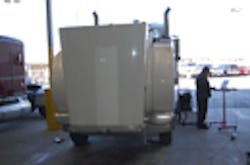New OBD diagnostic rules being phased in for commercial trucks
To ensure that mandated emission control technology is working properly, a series of federal onboard diagnostic (OBD) rules will be phased in over the next nine years to establish electronic “sensor standards” that verify truck exhaust pollution is being reduced to the required levels.
“For 2010 and beyond, the Environmental Protection Agency (EPA) has introduced regulations requiring OBD systems on heavy-duty engines used in trucks over 14,000 lbs.,” Ed Saxman, powertrain product manager for Volvo Trucks North America (VTNA) , told Fleet Owner.
“For 2013, OBD is required on all engine families, with all emission-related electronic sensors and actuators required to be monitored,” he added. “The EPA is also requiring OEMs to provide the service and repair industry with information necessary to maintain and fix OBD systems and other emission-related engine and aftertreatment components.”
In a nutshell, these new OBD sensors are designed to detect excessive NOx [oxides of nitrogen] and PM [particulate matter] emissions at very low levels. For example, last year, the first phase of the OBD rules required such “detection sensors” to indicate when NOx and PM emissions exceeded by five times the acceptable pollutant level.
By 2013, however, that threshold will get ratcheted down to three times the acceptable level – with the thresholds continuing to drop even more until 2019.
Steve Ostarello, vp-powertrain product development for Navistar, explained to Fleet Owner that the new OBD rules are to further ensure that if an emissions-control device goes out of range or becomes inoperative, the system automatically notifies the vehicle’s operator.
“The OBD system must also provide a fault code to the service technician that tells the root cause of the issue,” he pointed out. “However, OBD does not require automatic remediation of the issue, only that there is a malfunction indicator lamp (MIL) alert concerning the fault. This means that OBD regulations require engine OEMs to have an electronic system capable of monitoring the function and threshold levels of all emission-control devices, lighting a MIL if an emission fault should occur.”
Ostarello added that such electronic monitors are required for items such as sensors, EGR valves and coolers, intake throttle valves, and aftertreatment controls/sensors.
VTNA’s Saxman also noted that the OBD requirements will change emission-monitoring sensors already in place on 2007 EPA emission-compliant trucks as well.
“The EPA’s 2007 emissions standards required OEMs to implement engine manufacturer diagnostics (EMD) that use a malfunction indicator lamp (MIL) to detect emission system-related malfunctions,” he explained. “[But] the EMD conditions for illuminating and extinguishing the MIL are not as demanding as those for OBDs. So, by 2013, EMD systems will be phased out and all heavy-duty engines will incorporate OBD systems.”
David McKenna, director of powertrain sales & marketing for Mack Trucks, emphasized to Fleet Owner that both the EPA and the California Air Resources Board (CARB) have established requirements mandating OEMs to install OBD-system monitoring of all emission-related electronic sensors. He noted that Mack has already mapped out an installation plan for this technology.
“We currently have the full suite of OBD installed and functioning on our MP8 series of engines, with the full OBD system phased to be phased in on our MP7 and MP10 engines over the next 18 months,” he said.
About the Author
Sean Kilcarr
Editor in Chief
Sean Kilcarr is a former longtime FleetOwner senior editor who wrote for the publication from 2000 to 2018. He served as editor-in-chief from 2017 to 2018.
